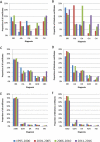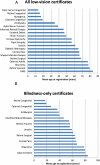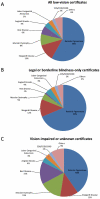Inherited retinal diseases are the most common cause of blindness in the working-age population in Australia
- PMID: 33939573
- PMCID: PMC8315212
- DOI: 10.1080/13816810.2021.1913610
Inherited retinal diseases are the most common cause of blindness in the working-age population in Australia
Erratum in
-
Correction.Ophthalmic Genet. 2021 Dec;42(6):790. doi: 10.1080/13816810.2021.1976939. Epub 2021 Sep 7. Ophthalmic Genet. 2021. PMID: 34493158 Free PMC article. No abstract available.
Abstract
Background: This study examined the frequency of inherited retinal diseases (IRDs) as the reason for blindness registrations over the last two decades and the demographic and clinical phenotypes of inherited retinal disease (IRD)-related registrations.Materials and methods: Retrospective, observational study of individuals registered with a state-wide blind and vision-impaired registry. Low-vision or blindness-only (≤20/200 or ≤20°) certificates issued to children (0-15 years), working-age (16-64 years) and older-age (65 and older) adults were assessed. Sex and age distributions were examined for the top 20 reasons for certification. Demographic and clinical features of specific phenotypes of IRDs listed in the registry were examined.Results: Amongst 11824 low-vision certificates issued between July 1995 and January 2017, 679 (5.7%) listed an IRD as the reason for registration. In individuals with blindness-only certification (N=4919), IRDs was the second most common diagnosis (8.3%), overtaking glaucoma (8.1%) and diabetic retinopathy (5.4%). IRD was the second most common reason for low-vision certification amongst children (11.6%) and the most common reason amongst working-age population (23.3%). The mean±SD age for IRD-related blindness-only certification was 46±20 years. The top three phenotypes of IRD-related low-vision certification were non-syndromic retinitis pigmentosa (54%), Stargardt disease (12%) and macular dystrophy (8%).Conclusion: Our findings of IRDs as a common cause of blindness in all ages justify continued funding for providing low-vision services and developing treatments for these conditions.
Keywords: Epidemiology; blind Registry; retinal Dystrophy; retinitis Pigmentosa; stargardt Disease.
Figures



Similar articles
-
Registered blindness and low vision in Kuwait.Ophthalmic Epidemiol. 2005 Aug;12(4):251-7. doi: 10.1080/09286580591005813. Ophthalmic Epidemiol. 2005. PMID: 16033746
-
Trends in blind and low vision registrations in Taipei City.Eur J Ophthalmol. 2008 Jan-Feb;18(1):118-24. doi: 10.1177/112067210801800120. Eur J Ophthalmol. 2008. PMID: 18203096
-
Trends in the incidence and causes of severe visual impairment and blindness in children from Israel.J AAPOS. 2015 Jun;19(3):260-5.e1. doi: 10.1016/j.jaapos.2015.04.002. J AAPOS. 2015. PMID: 26059674
-
A multidisciplinary approach to inherited retinal dystrophies from diagnosis to initial care: a narrative review with inputs from clinical practice.Orphanet J Rare Dis. 2023 Jul 31;18(1):223. doi: 10.1186/s13023-023-02798-z. Orphanet J Rare Dis. 2023. PMID: 37525225 Free PMC article. Review.
-
Global certification of visual impairment registries: A scoping review.Acta Ophthalmol. 2025 Feb;103(1):7-15. doi: 10.1111/aos.16763. Epub 2024 Sep 28. Acta Ophthalmol. 2025. PMID: 39340236 Free PMC article.
Cited by
-
Current management of inherited retinal degenerations in Portugal (IRD-PT survey).Sci Rep. 2024 Sep 14;14(1):21473. doi: 10.1038/s41598-024-72589-4. Sci Rep. 2024. PMID: 39277603 Free PMC article.
-
Models and Algorithms for the Refinement of Therapeutic Approaches for Retinal Diseases.Diagnostics (Basel). 2023 Mar 3;13(5):975. doi: 10.3390/diagnostics13050975. Diagnostics (Basel). 2023. PMID: 36900119 Free PMC article.
-
Stem cell therapy for inherited retinal diseases: a systematic review and meta-analysis.Stem Cell Res Ther. 2023 Oct 5;14(1):286. doi: 10.1186/s13287-023-03526-x. Stem Cell Res Ther. 2023. PMID: 37798796 Free PMC article.
-
Clinical exome analysis and targeted gene repair of the c.1354dupT variant in iPSC lines from patients with PROM1-related retinopathies exhibiting diverse phenotypes.Stem Cell Res Ther. 2024 Jul 2;15(1):192. doi: 10.1186/s13287-024-03804-2. Stem Cell Res Ther. 2024. PMID: 38956727 Free PMC article.
-
Stargardt disease: monitoring incidence and diagnostic trends in the Netherlands using a nationwide disease registry.Acta Ophthalmol. 2022 Jun;100(4):395-402. doi: 10.1111/aos.14996. Epub 2021 Aug 25. Acta Ophthalmol. 2022. PMID: 34431609 Free PMC article.
References
-
- Bertelsen M, Jensen H, Larsen M, Lorenz B, Preising MN, Rosenberg T. Prevalence and diagnostic spectrum of generalized retinal dystrophy in danish children. Ophthalmic Epi. 2013;20:164–69. - PubMed
-
- Bertelsen M, Jensen H, Bregbhoj JF, Rosenberg T. Prevalence of generalized retinal dystrophy in Denmark. Ophthalmic Epidemiol. 2014;21:217–23. - PubMed
Publication types
MeSH terms
LinkOut - more resources
Full Text Sources
Other Literature Sources
Medical
